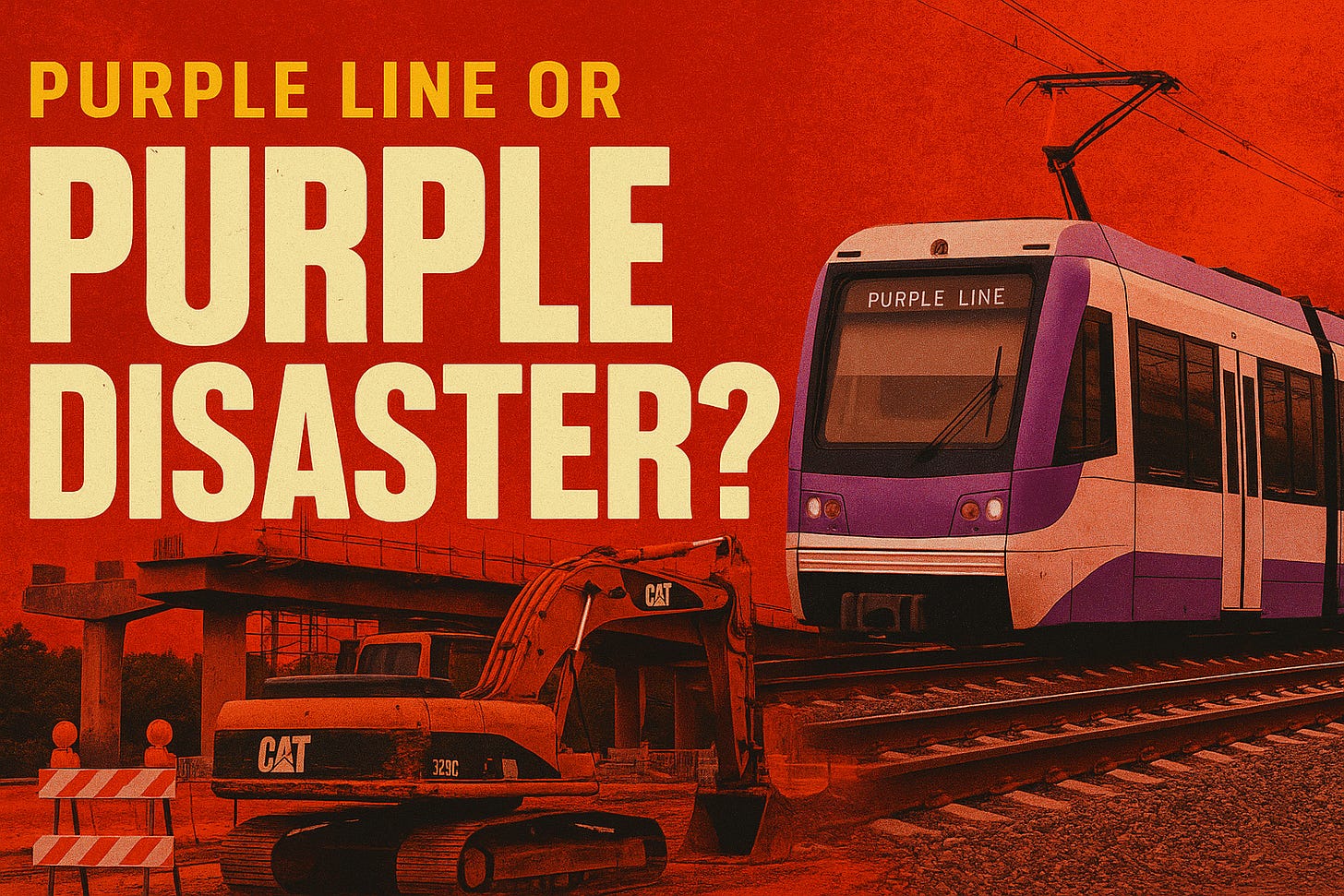Purple Line or Purple Disaster? How Maryland’s $9 Billion Transit Boondoggle Became the Punchline of State Planning
It’s not every day in Maryland politics that a government fiasco grows so large and embarrassing that even the governor gets a pass. But that’s precisely what has happened with the infamous WMATA Purple Line — the east-west light rail project initially billed as a $2.4 billion transit solution for the Washington suburbs. Now ballooning toward $9 billion, with a nearly decade-long delay, the Purple Line isn’t just a construction nightmare — it’s a flashing neon sign of everything wrong with Maryland’s government planning, procurement, and fiscal responsibility.
And no — you can’t blame Wes Moore for this one. Not even close.
The Original Vision… and the Crumbling Reality
When first announced under the O’Malley administration and rubber-stamped during the Hogan years, the Purple Line was supposed to be a shining example of Maryland’s commitment to public transit, smart growth, and regional connectivity. Spanning 16 miles from Bethesda to New Carrollton, it was pitched as a public-private partnership (P3) that would deliver modern transit infrastructure on-time and under budget.
Fast forward to 2025, and the Purple Line is now the poster child for everything wrong with that vision. After legal battles, utility delays, cost inflation, contractor walk-offs, and failed oversight, the line still isn’t complete. Once expected to be operational by 2022, the latest estimates suggest service may not begin until 2027 — and that’s if you’re an optimist.
A Fiscal Sinkhole for the State
Let’s talk numbers. The original contract value was just under $6 billion, including construction and 30 years of operations. But by the time the state had to settle with the original contractor for $250 million in 2020 and re-bid the project at a higher cost, Maryland taxpayers were already deep in the hole.
Today, the all-in cost is pushing toward $9.3 billion — nearly four times the original construction estimate. For context, that’s more than the entire annual budget of Baltimore City. It’s more than double what Florida spent on its Brightline high-speed rail between Miami and Orlando, which actually runs.
So where did the money go? Legal delays, labor shortages, inflation, permitting problems, and uncoordinated local infrastructure upgrades all played a role. But the truth is simpler: Maryland politicians rushed into a complex infrastructure deal without a plan for execution. And when the house started to burn, they just kept pouring gasoline.
A Bipartisan Failure
While Wes Moore’s administration is now tasked with cleaning up the mess, this isn’t his Frankenstein. The Purple Line was born under Democrat Martin O’Malley and carried forward by Republican Larry Hogan — making it a rare case of bipartisan failure. O’Malley pushed the project forward with little regard for long-term feasibility, while Hogan insisted on a public-private partnership without enough oversight or contingency planning.
This is the legacy of Maryland’s ruling class: expensive virtue signaling without the competence to match.
The current administration has been mostly silent on the Purple Line’s failures. There’s no investigation, no real accountability, and no strategy to prevent this kind of disaster from happening again. Why? Because to admit the truth about the Purple Line is to admit that Maryland's entire transit strategy has been a fantasy sold by bureaucrats and consultants who never plan to ride the train.
Collateral Damage to Maryland’s Economy
The damage from this debacle extends far beyond the rails. Businesses along the route, especially in Prince George’s and Montgomery Counties, have suffered years of street closures, construction noise, and economic stagnation. Promised development booms have been delayed or canceled outright. The small businesses that politicians love to champion have instead been choked by the dust and debris of endless infrastructure “progress.”
And then there’s the opportunity cost. While Maryland pours billions into a train that doesn’t run, roads crumble, schools remain underfunded, and rural counties are ignored. The working-class residents of western Maryland and the Eastern Shore see nothing but urban favoritism and elite incompetence. Is it any wonder the state is losing its competitive edge?
What Comes Next?
At this point, the only way forward is to finish the job — but with radical transparency and a hard reset on Maryland’s infrastructure planning process. That includes:
Immediate public audits of all contracts and subcontracts.
A cap on further overruns, enforced with clawbacks or penalties.
A legislative investigation into the P3 model that enabled this disaster.
A moratorium on new megaprojects until Maryland proves it can finish the ones it starts.
The Purple Line was supposed to connect people, reduce traffic, and spur growth. Instead, it’s become a political ghost train — running on dollars instead of tracks, fueled by hubris instead of horsepower.
Maryland deserves better than a decade-long construction zone and a bloated budget line. The taxpayers didn’t sign up to fund a monument to mediocrity. It's time to lay the final tracks — and then lay down some accountability.





